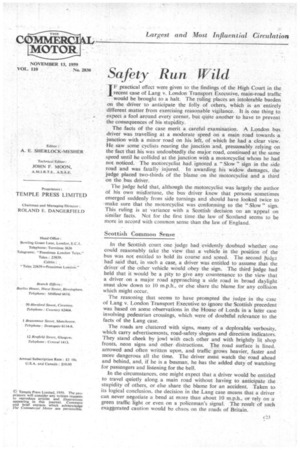Safety Run Wild
Page 73

If you've noticed an error in this article please click here to report it so we can fix it.
.IF practical effect were given to the findings of the High Court in the recent case of Lang v. London Transport Executive, main-road traffic would be brought to a halt. The ruling places an intolerable burden on the driver to anticipate the folly of others, which is an entirely different matter from exercising reasonable vigilance. It is one thing to expect a fool around every corner, but quite another to have to prevent the consequences of his stupidity., The facts of the case merit a careful examination. A London bus. driver was travelling at a moderate speed on a main road towards ,a junction with a minor -road on his left, of .which he had a clear view. He saw some cyclists nearing the junction and, presumably relying on the fact that his was undoubtedly -the major road, continued at the same speed until he collided at the junction with a motorcyclist whom he had not noticed. The motorcyclist had ignored a "Slow" sign in the side road 'and was fatally injured. In awarding his widow damages, the judge placed two-thirds of the blame on the mOtorcyclist and a third on the bus driver.
The judge held that, although the motorcyclist was largely the author Of his own misfortune, the busdriver knew that persons sometimes emerged suddenly from side turnings and should have looked twice to 'make sure that the motorcyclist was conforming -to the "Slow " sign. This ruling is at variance with a Scottish decision on an appeal on similar facts. Not for the first time_ the law of Scotland seems to be more in accord with common sense than the law of England.
Scottish COMM041 Sense In the Scottish court one judge had evidently doubted whether, one could reasonably take the view that a vehicle in the position of the bus was not entitled to hold its course and speed. The second fudge had said that, in such a case, a driver was entitled to assume that the driver of the other vehicle would obey the sign. The third judge had held that it would be a pity to give any countenance to the view that a driver on a major road approaching a side. road in broad daylight must slow down to 10 m.p.h., or else share the blame for any collision which might occur.
The reasoning that seems to have prompted the judge in the case of Lang v. London Transport Executive to ignore the Scottish precedent was based on some observations in the House of Lords in a later case involving pedestrian crossings, which were of doubtful relevance to the facts of the Lang case.
The roads are cluttered with signs, many of a deplorable verbosity, which carry advertisements, road-safety slogans and direction indicators. They stand cheek by jowl with each other and with brightly lit shop fronts, neon signs and other. distractions. The road .surface is lined, arrowed and often written upon, and traffic grows heavier, faster and more dangerous all the time. The driver must watch the road ahead and behind, and, if he is a busman, he has the added duty of watching for passengers and listening for the bell.
In the circumstances, one might expect that a driver would be entitled to travel quietly along, a main road without having to anticipate the stupidity of others, or else share the blame for an accident. Taken to its logical conclusion, the decision in the Lang case means that a driver can never negotiate a bend at more than about 10 m.p.h., or rely on a green traffic light or even on a policeman's signal. The result' of such exaggerated caution would be chaos on the roads of Britain.
































































































































































































































































